
Provocateurs appear in border towns
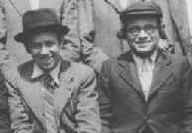 |
On 8 November 1938, one day before the Crystal Night,
strange persons who had never been seen there before suddenly appeared in several small
towns in Hessen near the French-German border. They went to mayors, Kreisleiters (district
Party leaders) and other important officials in these towns and asked them what actions
were being planned against the Jews. The officials were rather startled by these questions
and replied that they didn't know of any such plans. The strangers acted as if they were
shocked to hear this. They shouted and complained that something had to be done against
the Jews and then, without further explanation, they disappeared. |
| They usually regarded the strangers as crazy
anti-Semites and promptly forgot about the incidents - until the next evening. Some of
these apparently crazy individuals really outdid themselves. |
Provocateurs dress as SS
 |
In one case two men, dressed as members of the SS, went to
an SA Standartenfuehrer (Colonel) and ordered him to destroy the nearby synagogue. To
understand the absurdity of this one must know that the SS and SA were completely separate
organizations. A real SS member would never have tried to give orders to an SA unit. This
case shows that the strangers were foreigners who did not even understand the distinctions
of German authority. The SA Standartenfuehrer rejected the demands of the self-styled SS
men and reported the incident to his superiors. |
Strangers giving speeches
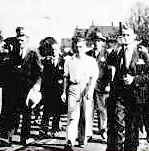 |
When the provocateurs realized that their efforts were not
working with local officials, they changed their tactics. Instead they tried to incite
directly the people in the streets. In another town, for example, two men appeared at the
market place and began making speeches to the people there, trying to incite them against
the Jews. Eventually some people did indeed storm the synagogue, but by then the two
provocateurs had, of course, disappeared. Similar incidents occurred in several towns. |
| Unidentified strangers suddenly appeared, gave
speeches, started throwing stones at windows, stormed Jewish buildings, schools,
hospitals, and synagogues, and then disappeared. |
These unusual incidents had already started on the 8th of November, that
is, before Ernst vom Rath was dead. His death was only reported late on the evening of the
9th. The fact that this strange pattern of incidents had already begun one day earlier
proves that the death of vom Rath was not the reason for the Crystal Night outburst. Vom
Rath was still alive when the pogrom began.
These were methodical thugs and not enraged citizens
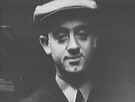 |
Well organized and widespread incidents began on the
evening of 9 November. Groups of generally five or six young men, armed with bars and
clubs, went down the streets smashing store windows. They were not Jew-hating SA men,
enraged over the murder of a German diplomat. They operated too methodically to have been
motivated by anger. They carried out their work without any
apparent emotion. Nonetheless, it was their destruction |
| that encouraged certain other individuals from
the lowest social classes to become a mob and continue the destruction. |
All one can learn from history writers is that "all" synagogues were demolished
and that "all" shop windows were destroyed. Aside from this vague description,
one is given almost no details.
Jews fought off attacks
History writers tell us that during the Crystal Night all the Jews were frightened, meekly
accepted whatever happened to them and watched the destruction of their property with no
resistance. The contrary is true. While going through the files on this subject, I found
many documents which report precisely just the opposite of what is claimed. The fact is
that in many cases Jews and their German neighbors fought together against the attackers,
pushing them down staircases. Street mobs were beaten up and chased away in more than one
case.
| Police on side of Jews |
SA officers stood watch
preventing attacks
Police and Party officials were generally on the side of the Jews. Some
Jewish community leaders went to police stations the next morning and asked the police to
investigate the damage done to their synagogues. The resulting police reports are still
available in the files today. |
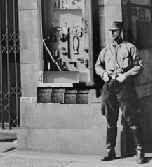 |
Jews weren't phased by attacks
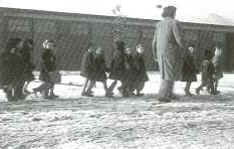 |
Also contrary to what we have been told, most
Jews were not directly affected by these events. In Berlin, for example, all of the
teachers and pupils of the city's largest Jewish school, which served the entire Berlin
area, appeared in their classes the next morning without having noticed anything unusual
during the previous night. Heinemann Stern, the Jewish principal
of that school, wrote in his postwar memoirs that he noticed a burning synagogue on his
way to the school on the morning after the Crystal Night, but he thought it was just an
accidental fire. |
It was only after he arrived at the school that he received a telephone
call informing him of the destruction of the previous night. He then went on with his
classes of the day and only during the first recess did he take the trouble to inform the
entire student body about what had happened.
Jewish historians rewrote history
Historians wrote: "Every single Jew was beaten, chased, robbed,
insulted and humiliated. The SA tore the Jews from their beds, mercilessly beat them in
their apartments and then ... chased them almost to death ... Blood flowed
everywhere."
[9] Is it conceivable that thousands of Jewish children would be have
been sent to school by their parents on the morning after that fateful night if the
attacks against Jews had been so horrific or extensive? Would any parents have let their
children go to school if they had thought there was even the slightest danger of them
being attacked by roving gangs of SA men? I think the answer is clearly no!
Who Could the Provocateurs Have Been?
In the wake of the Crystal Night, almost everyone wanted to know who the culprits were.
Dr. Goebbels expressed his suspicion that a secret organization must have instigated the
entire affair. He simply could not believe that anything so well organized could have been
a spontaneous popular outburst.
Apparently to avoid internal wrangling and the harm that this would do
to their public image, an investigation to determine the instigators never took place.
Hitler believed that Dr. Goebbels, his closest confidant and the one man he could never
abandon, had been the instigator.
The only persons actually punished were individual SA men who had participated directly in
the pogrom and been accused in German courts of murder, assault, looting or other criminal
acts by Jewish or German witnesses to these crimes. But before any of these cases ever
actually came to trail, Hitler issued a special decree ordering the postponement of all
such cases until after the accused individuals were first prosecuted by the Supreme Party
Court, an internal court concerned with discipline within the National Socialist Party
organization.
Mystery phone calls to local town officials
 |
Several district and local Party leaders (Kreisleiters and
Ortsgruppenleiters) were awakened from their sleep in the middle of the night by telephone
calls. Someone claiming to be from the regional Party headquarters or the regional Party
propaganda bureau (Gauleitung or Gaupropagandaleitung) would ask what was happening in the
official's town or city. If the Party official answered "Nothing, everything is
quiet," the telephone caller would then say in German slang that he had received an
order to the effect that the Jews were going to get it tonight and that the respective
official should carry out the order. |
In most cases the Party leader, disturbed from his sleep, did not even
understand what had happened. Some simply dismissed the call as a joke and went back to
bed.
Others called back the office from where the telephone voice had
pretended to be calling. If they managed to reach someone in charge, they were often told
that nobody knew anything about such a call. But if they reached only a lower official
they were often told: "Well, if you got that order, you'd better go ahead and do what
you were told." These telephone calls caused considerable confusion. All this came
out months later during the trials conducted by the Supreme Party Court. The Chief Judge
concluded that in every case a misunderstanding had arisen in one link or other of the
chain of command. But when they were confronted with apparently genuine orders to organize
demonstrations against the Jews that night, most of the Party leaders had simply not known
what to do.
Obviously a group of centrally organized thugs
The pattern of seemingly sporadic anti-Jewish incidents in small towns, followed only
later by a carefully planned outburst in many large cities throughout Germany, clearly
suggests the work of a centrally organized group of well-trained agents. Even shortly
after the Crystal Night, many leading Party officials suspected that the entire affair had
been centrally coordinated. Significantly, even Hermann Graml, the only West German
historian who has written in detail about the Crystal Night, carefully distinguished
between provocateurs and people who were simply carried away by their emotions and
spontaneously took part in the riot and destruction.
The
timing was perfect
Most party officials were at a commemoration at the
Alte Rathaus in Munich
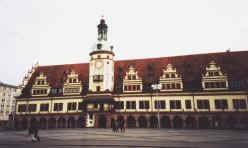 |
Munich on the Ninth of November
| While all this was happening across the Reich, a special
annual commemoration was being held in Munich. Fifteen years earlier, on 9 November 1923,
a movement led by Adolph Hitler, Erich von Ludendorff (a leading First World War General),
and two major figures in the Bavarian government tried to depose the legal government and
take responsibility themselves as a new national government. |
 |
|
| Feldherrnhalle |
|
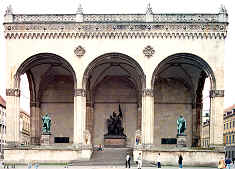 |
The uprising or putsch was put down and 16 rebels were shot
down next to the Feldherrnhalle, a famous old monument building in central Munich.
Accordingly, the 9th of November had been commemorated every year since 1933 as the
memorial day for the martyred heroes of the National Socialist movement. Adolph Hitler and
the Party veterans, as well as all of the Gauleiters (regional Party leaders) met every
year in Munich for the occasion. Hitler would usually deliver a speech to a select
audience of Party veterans at the famous Buergerbraeukeller restaurant on the evening of
the 8th. |
|
|
| Hitler and veterans
reenact On the morning of the 9th Hitler and his veteran
comrades would reenact the 1923 "March to the Feldherrnhalle." |
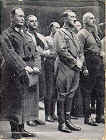 |
|
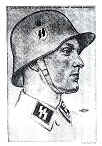 |
SS ceremony On the
evening of the 9th the Fuehrer always held an informal dinner at the Old Town Hall
("Alte Rathaus") with old comrades as well as all the Gauleiters. At midnight
young men who were about to enter the SS and the SA were sworn in at the Feldherrnhalle.
All of the Gauleiters and other guests participated in this very solemn
ceremony. After it was over they left Munich and returned to their homes throughout the
Reich. |
| Gaulieters not at
posts
It is clear that the 9th of November date was chosen very cleverly. The annual
commemoration ceremony of that day insured that almost all of the Gauleiters would be away
from their home offices when the anti-Jewish demonstrations began. In other words, the
actual decision-making responsibilities that were normally carried out by the Gauleiters
were temporarily in the hands of lower-ranking individuals with less experience.
|
Between 8 and 10 November, subordinate officials stood in for the
Gauleiters who were either in Munich or en route to or from the annual commemoration
there. This temporary transfer of decision-making authority is very important because it
contributed to much of the subsequent confusion and thus helped the provocateurs. Another
contributing factor was the fact that no one expected any trouble. At that time Germany
was one of the most peaceful countries in the world.
There was no reason to expect any kind of unrest. It was only during dinner at the Old
Town Hall that the first sporadic reports of riot and destruction reached Munich from some
of the Gauleiter's home offices. At the same time it was learned that Ernst vom Rath had
died in Paris from his wounds.
What Was Goebbels Doing?
 |
After the dinner was over, the Fuehrer left at about 9 p.m.
and returned to his apartment. Dr. Goebbels then stood up and spoke briefly about the
latest news. He informed the audience that vom Rath had died and that, as a result,
anti-Jewish demonstrations had spontaneously broken out in two or three places. Goebbels
was renowned for his passionate and inspiring speeches. But what he gave that evening was
not a speech at all but only a short and very informal announcement. |
He suggested that the Gauleiters and the head of the SA, Viktor Lutze, should contact
their home offices to make sure that peace and order were being maintained.
You may have heard the widespread allegation that Goebbels started the Crystal Night
pogrom with a fiery speech on that evening of 9 November. This widely accepted story is
false. The following facts will clarify this point:
As Gauleiter for Berlin, Dr. Goebbels had no authority outside of his Berlin district.
Although he was also the Propaganda Minister of the German government, this did not give
him any authority over Party officials. Furthermore, he had no authority whatsoever over
the SA or the SS.
| Goebbels understood this damaged the
Reich international standing |
| Of all the National Socialist leaders, Dr.
Goebbels would have understood better than anyone else the immense damage that an
anti-Jewish pogrom would cause for Germany. On the morning of 10 November, when he first
learned about the extent of the damage and destruction of the previous night, he was
furious and shocked at the stupidity of those who had participated. How could a speech given after 9 p.m. on the evening of 9 November have possibly
incited a "pogrom" which had already begun the day before when the first
provocateurs appeared at municipal and Party offices to persuade officials to take action
against the Jews? |
| Gauleiters telephoned
subordinates to maintain peace |
| The Gauleiters and the SA commander
went to the telephones and called their respective home offices to order their
subordinates to do everything necessary to maintain peace and order. They emphasized that
under no circumstances must anyone take part in any demonstrations. These telephone
instructions were written down at the home offices by whoever was on duty. The orders from
each Gauleiter were then passed on by telex to other offices within the Gau or district.
These telex messages are still in various records files and are available to anyone who
wishes to examine them. |
Orders to Stop the Pogrom
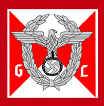 |
While the Gauleiters were calling their home offices, the
head of the SA, Viktor Lutze, ordered all of his immediate subordinates, the SA
Gruppenfuehrers, who were together with him in Munich, to call their home offices as well.
Lutze ordered that under no circumstances could SA men take part in any demonstrations
against Jews, and that furthermore the SA was to intervene to stop any demonstrations
already in progress. |
| SA, Viktor Lutze gives orders to protect Jews As a result of these strict orders, SA men began to guard Jewish stores that very
night wherever windows had been broken. There is no doubt about this order by Lutze
because we have the postwar court testimony of several witnesses confirming it. The SS and
the police were given similar orders to restore peace and order. |
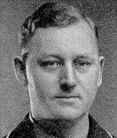 |
Heydrich orders SS to protect Jews
 |
Himmler ordered Reinhard Heydrich to prevent all
destruction of property and to protect Jews against demonstrators. The telex communication
of this order still exists. It is in the files of the International Military Tribunal in
Nuremberg.
| However, during the Nuremberg trial this
telex order was presented in three different forms, with forged amendments to change the
original meaning. In my book Feuerzeichen I undertook to restore
the original text. |
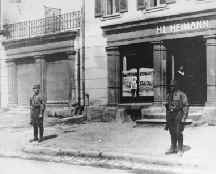 |
|
Hitler was furious
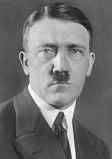 |
Adolf Hitler joined the midnight celebration at the
Feldherrnhalle. It was only after he returned to his apartment about one o'clock in the
morning that he learned about the demonstrations which had been taking place in Munich,
during which one synagogue had been set on fire. He was furious and immediately ordered
the police chief of Munich to come see him. Hitler told him to immediately stop the fire
and to make sure that no other outrages took place in Munich. He then called various
police and Party officials throughout the Reich to learn the extent of these
demonstrations |
Finally, he ordered a telex message sent to all Gauleiter offices. It
read: "By express order from the very highest authority, arson against Jewish
businesses or other property must in no case and under no circumstances take place."
Synagogues were not specifically mentioned, apparently because Hitler was still unaware of
the burning of synagogues, apart from the one in Munich.
How Did the SA Get Involved Despite the Orders From Its Own Leaders?
According to the records, at least three of the 28 SA Groups did not obey the orders of SA
chief Lutze. Instead, they sent out their men to destroy synagogues and Jewish buildings.
In effect they did precisely the opposite of what Lutze had ordered. What actually
happened is clear from the testimony and evidence presented at postwar trials against
former SA men accused of participating in the riot.
Provocateurs sent messages to SA Brigade
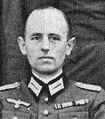 |
The trials, held between 1946 and 1952, were based to a
large extent on the report of SA Brigade 50 chief Karl Lucke and begins with these words:
"On 10 November 1938, at 3 o'clock in the morning, I received the following order:
'By order of the Gruppenfuehrer, all Jewish synagogues within the Brigade district are to
be immediately blown up or set on fire'." Lucke then included in his report a listing
of synagogues which had been destroyed by members of his Brigade. |
This report has been cited by the prosecution at the Nuremberg Tribunal
and by practically all of the consensus historians ever since as proof that the SA was
given orders to destroy Jewish stores and synagogues.
Lutze ordered the Group leaders to contact their home offices to stop all anti-Jewish
demonstrations, Fust, along with the other SA leaders, did just that. He called his office
in Mannheim and passed on the orders he had received from Lutze. The man who was on duty
that night at the Mannheim SA office telephone and who received Fust's order confirmed
that he understood it and then hung up. But he never passed on the order he had received.
Instead, he transmitted precisely the opposite order.
Fritsch gets bogus orders
 |
The normal procedure would have been for the man on duty at
the telephone to immediately call the deputy group leader, Lucke, who was in nearby
Darmstadt. But instead he called SA Oberfuehrer (senior colonel) Fritsch and asked him to
come to the office. Fritsch had a reputation for not being particularly clever. When he
arrived, the man who had received the telephone call showed him a small paper slip with a
few notes on it which said that the synagogues within the Mannheim SA Group district were
to be destroyed. |
The man who had received the call explained to Fritsch that the order
had just arrived from Munich. Slow-minded as he was, Fritsch did not know what to do and
called the local Kreisleiter (district Party leader) and his deputy. These two men then
arrived at the SA office and discussed the situation, while at the same time the telephone
duty man notified other SA leaders, but still not the deputy Group leader Lucke. In the
meantime the small paper slip disappeared and the SA men now arriving at the headquarters
met only the Kreisleiter, who told them about the order which he thought had come from
Munich. No one asked for any further confirmation. The SA men then left to begin the
destruction. Hours later, when the whole action was almost finished, the telephone guard
finally called Deputy Group Leader Lucke and passed on the false order. He also informed
Lucke that the action had already been going on for several hours. Since it was almost all
over by this time, Lucke also neglected to ask for confirmation of the order. It was
already 3 o'clock in the morning. Lucke then alerted the Standartenfuehrer of his Brigade
and carried out the destruction within the Darmstadt district.
Mysterious telephone call
At 8 o'clock the next morning Lucke sat down and wrote the report which was later cited at
the Nuremberg Tribunal. In fact, as already shown, there was no order to commit arson or
carry out destruction against any Jewish property from the Gruppenfuehrer in Munich, but
only from the telephone guard. Who he was remains a mystery. During the postwar trials
against members of this SA unit, none of the judges asked for the name or identity of this
telephone guard. This mysterious man was very probably an agent for those who were
actually behind the entire Crystal Night Affair.
The Fine Imposed on the Jews
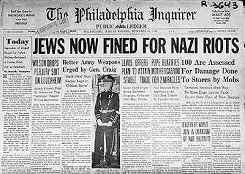 |
German government and Party officials were
furious about what had happened. Hermann Goering, who was responsible for Germany's
economy, complained that it would be impossible to replace the special plate glass of the
broken store windows because it was not manufactured in Germany. It had to be imported
from Belgium and would cost a great deal of precious foreign currency. |
Reason for fine
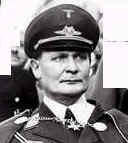 |
Because of the Jewish boycott against German goods, the
Reich was short of foreign exchange currency. Goering therefore decided that because this
shortage was caused by the Jews, it was they who would have to pay for the broken glass.
He imposed a fine of one billion Reichsmarks on the German Jews. It
was certainly unjust to force Jews to pay for damage which they had not caused. Goering
understood this. However, in private he justified the fine by citing the fact that the
1933 Jewish declaration of war against Germany was proclaimed in the name of the millions
of Jews throughout the world. |
Therefore they could now help their co-religionists in Germany bear the
consequences of the boycott. It should also be pointed out that only German Jews with
assets of more than 5,000 Reichsmarks in cash had to contribute to the fine. In 1938, when
prices were very low, 5,000 Reichsmarks was a small fortune.
The Reich confiscated all insurance payments that were to
have been paid to Jews whose businesses and homes were looted or destroyed and the Jewish
owners were made personally responsible for the cost of all repairs.
|